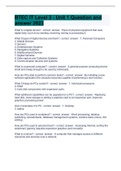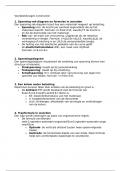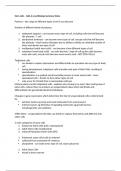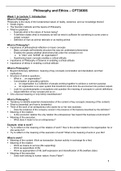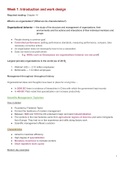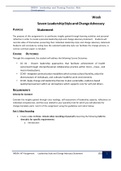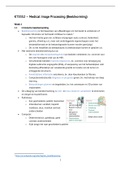Talent, development and creativity
Week 1
Definitions
Talent is a potential to reach excellence in the future. It’s a natural ability to be
good at some domain. It may instead emerge from a multidimensional,
multiplicative and dynamic process. Creativity is the creation or production of
something new. It has to be original, useful and surprising. Even creative experts
vary greatly in speed of expertise acquisition and in the magnitude of their
performance based on that acquired expertise. Both talent and creativity can
have two different approaches:
- Normative approach= high performance relative to others. Used at the
experts level.
- Ipsative approach= improving performance relative to one’s previous
performance.
There are component-dominant ideas, which holds nature/nurture and
multidimensional models. And there are interaction-dominant ideas, which holds
that talent and creativity are emergent.
Simonton : “Talent may instead emerge from a multidimensional, multiplicative,
and dynamic process.” He also said that deliberate practice may hinder creativity
and that talent can be lost/change over time.
How did it all begin?
Francis Galton (1869) concluded that talent is located in the person, so the
nature approach. He said that it must be transmitted from parents to their
offspring. However, you need to have the motivation for performing
exceptionally. Alphonse de Candolle (1873) concluded that talent is elicited by
the environment, so the nurture approach. De Groot (1946/1965) found that
through experience, people can get skills needed for good performance. So he
concluded that many hours of practice is needed, he especially focused on chess.
There is evidence for the importance of genetic factors in talent and creativity
development. For example with twin studies. Another example is the heritage
project in sport and exercises, it was found that 50% of the sport results could be
attributed to genetics. The heritability of IQ is domain general. On the other hand,
there is also evidence for the importance of innate factors in talent and creativity
development. Those are the child prodigies (‘wonderchildren’) and domain
specific excellence at early age.
Parents play an important role in the development of their child’s talent and the
role differs over time. The 10.000 hours practice rule, is very much discussed
now. The variation among those hours is enormous across different domains and
it may hinder creativity or increase the risks of burnout and injury. More recent
research emphasizes the role of psychological factors now. Deliberate practice
are activities that have been specially designed to improve the current level of
performance. It is important, but not as important as has been suggested by Erik
Ericsson.
Nature Nurture Both
Galton DeCandolle and Ericcson Simonton
, Nature Nurture
Prodigies, early talent selection and heritage Deliberate practice
project
Maximization of deliberate practice is neither short-lived nor simple. It extends
over a period of at least 10 years and involves optimization within several
constraints: resources, motivation and effort.
This model shows:
- I An introduction to activities in the domain and start of deliberate practice
- II Extended period of preparation and commitment to pursue activities full-
time
- III Full-time commitment of improving performance and become a
professional
- Optional IIII go beyond knowledge of the teachers to make a unique
contribution
Endurance athletes have a much higher aerobic ability, larger hearts, more
capillaries supplying blood to muscles, and a higher percentage of slow-twitch
muscle fibres.
Multidimensionality and a complex interaction dominant process
There can be multiplier effects or compensation effects, strengthening each other
over time. Early signs of later excellence are rare. Talent can be lost, because an
individual’s talent changes over time. Different children begin to exhibit the same
talent at different ages (early vs. late bloomers).
A dynamic network model shows that talent develops through dynamic
interactions between components. A relatively simple dynamic network,
consisting of 10 sparsely connected nodes, generates patterns of ability
development that are in accordance with the
proposed developmental properties of
excellent performance development: (a) Early
indicators of ultimate excellent abilities are
often lacking, (b) similar ability levels can
develop at different ages, (c) the underlying
constituents of the ability can change during
the individual’s lifespan, and (d) the ability-development can take a variety of
forms. Excellent performance can be measured in terms of productivity,
especially if this productivity is based on consensual expert assessment, as in
, science, technology, arts and sports. This network is interaction dominant.
Excellence emerges out of dynamic networks consisting of idiosyncratic mixtures
of interacting components such as genetic endowment, motivation, practice, and
coaching. The model is domain specific and individual-specific. The patterns
naturally emerge and account for multidimensionality. The distribution of such a
model has a skewed population, because the bests are way better than the rest.
Existing models that predict the generation of products are:
- The Poisson model from Huber, which states the probability that a
particular product will occur during a fixed time interval. The model has
also been presented as the blind-variation-and-selective-retention model
(BVSR model) or as Simonton’s equal odds baseline.
- The Matthew model is based on the success-breeds-success principle.
A complex dynamic systems model has dynamic interactions as the basis for
creative processes and
experiences.
Recap
Genes play a role in general measures, however in domain-specific talents it’s
hard to say if genes play a role. The differences between expert performers and
normal adults reflect a life-long period of deliberate effort to improve
performance in a specific domain. Only a few exceptions, most notably height,
are genetically prescribed. Expert performance is the result of an extended
process of skill acquisition mediated by large, but not excessive daily amounts of
deliberate practice. In the domain of music, individual differences in adult levels
of performance are correlated with the past and current amount of deliberate
practice at a given age, in particular the age of 18, when performers in music are
normally selected for higher levels of professional training.
Week 2
Theory
The Self-determination theory means the satisfaction of individuals’ psychological
needs for competence, autonomy, and relatedness and has been identified
as essential for sustaining optimal psychological functioning and motivation.
It’s linking competence and motivation to other satisfactions and incentives. It’s a
macrotheory of human motivation and personality development.
Week 1
Definitions
Talent is a potential to reach excellence in the future. It’s a natural ability to be
good at some domain. It may instead emerge from a multidimensional,
multiplicative and dynamic process. Creativity is the creation or production of
something new. It has to be original, useful and surprising. Even creative experts
vary greatly in speed of expertise acquisition and in the magnitude of their
performance based on that acquired expertise. Both talent and creativity can
have two different approaches:
- Normative approach= high performance relative to others. Used at the
experts level.
- Ipsative approach= improving performance relative to one’s previous
performance.
There are component-dominant ideas, which holds nature/nurture and
multidimensional models. And there are interaction-dominant ideas, which holds
that talent and creativity are emergent.
Simonton : “Talent may instead emerge from a multidimensional, multiplicative,
and dynamic process.” He also said that deliberate practice may hinder creativity
and that talent can be lost/change over time.
How did it all begin?
Francis Galton (1869) concluded that talent is located in the person, so the
nature approach. He said that it must be transmitted from parents to their
offspring. However, you need to have the motivation for performing
exceptionally. Alphonse de Candolle (1873) concluded that talent is elicited by
the environment, so the nurture approach. De Groot (1946/1965) found that
through experience, people can get skills needed for good performance. So he
concluded that many hours of practice is needed, he especially focused on chess.
There is evidence for the importance of genetic factors in talent and creativity
development. For example with twin studies. Another example is the heritage
project in sport and exercises, it was found that 50% of the sport results could be
attributed to genetics. The heritability of IQ is domain general. On the other hand,
there is also evidence for the importance of innate factors in talent and creativity
development. Those are the child prodigies (‘wonderchildren’) and domain
specific excellence at early age.
Parents play an important role in the development of their child’s talent and the
role differs over time. The 10.000 hours practice rule, is very much discussed
now. The variation among those hours is enormous across different domains and
it may hinder creativity or increase the risks of burnout and injury. More recent
research emphasizes the role of psychological factors now. Deliberate practice
are activities that have been specially designed to improve the current level of
performance. It is important, but not as important as has been suggested by Erik
Ericsson.
Nature Nurture Both
Galton DeCandolle and Ericcson Simonton
, Nature Nurture
Prodigies, early talent selection and heritage Deliberate practice
project
Maximization of deliberate practice is neither short-lived nor simple. It extends
over a period of at least 10 years and involves optimization within several
constraints: resources, motivation and effort.
This model shows:
- I An introduction to activities in the domain and start of deliberate practice
- II Extended period of preparation and commitment to pursue activities full-
time
- III Full-time commitment of improving performance and become a
professional
- Optional IIII go beyond knowledge of the teachers to make a unique
contribution
Endurance athletes have a much higher aerobic ability, larger hearts, more
capillaries supplying blood to muscles, and a higher percentage of slow-twitch
muscle fibres.
Multidimensionality and a complex interaction dominant process
There can be multiplier effects or compensation effects, strengthening each other
over time. Early signs of later excellence are rare. Talent can be lost, because an
individual’s talent changes over time. Different children begin to exhibit the same
talent at different ages (early vs. late bloomers).
A dynamic network model shows that talent develops through dynamic
interactions between components. A relatively simple dynamic network,
consisting of 10 sparsely connected nodes, generates patterns of ability
development that are in accordance with the
proposed developmental properties of
excellent performance development: (a) Early
indicators of ultimate excellent abilities are
often lacking, (b) similar ability levels can
develop at different ages, (c) the underlying
constituents of the ability can change during
the individual’s lifespan, and (d) the ability-development can take a variety of
forms. Excellent performance can be measured in terms of productivity,
especially if this productivity is based on consensual expert assessment, as in
, science, technology, arts and sports. This network is interaction dominant.
Excellence emerges out of dynamic networks consisting of idiosyncratic mixtures
of interacting components such as genetic endowment, motivation, practice, and
coaching. The model is domain specific and individual-specific. The patterns
naturally emerge and account for multidimensionality. The distribution of such a
model has a skewed population, because the bests are way better than the rest.
Existing models that predict the generation of products are:
- The Poisson model from Huber, which states the probability that a
particular product will occur during a fixed time interval. The model has
also been presented as the blind-variation-and-selective-retention model
(BVSR model) or as Simonton’s equal odds baseline.
- The Matthew model is based on the success-breeds-success principle.
A complex dynamic systems model has dynamic interactions as the basis for
creative processes and
experiences.
Recap
Genes play a role in general measures, however in domain-specific talents it’s
hard to say if genes play a role. The differences between expert performers and
normal adults reflect a life-long period of deliberate effort to improve
performance in a specific domain. Only a few exceptions, most notably height,
are genetically prescribed. Expert performance is the result of an extended
process of skill acquisition mediated by large, but not excessive daily amounts of
deliberate practice. In the domain of music, individual differences in adult levels
of performance are correlated with the past and current amount of deliberate
practice at a given age, in particular the age of 18, when performers in music are
normally selected for higher levels of professional training.
Week 2
Theory
The Self-determination theory means the satisfaction of individuals’ psychological
needs for competence, autonomy, and relatedness and has been identified
as essential for sustaining optimal psychological functioning and motivation.
It’s linking competence and motivation to other satisfactions and incentives. It’s a
macrotheory of human motivation and personality development.

